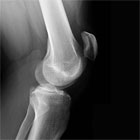 |
synonyms: patella tendon rupture
Patellar Tendon Rupture ICD-10
Patellar Tendon Rupture ICD-9
- 727.66(nontraumatic rupture of patellar tendon)
- 844.8(sprain/strain of knee)
- 891.2(open wound knee, leg, ankle with tendon involvement)
Patellar Tendon Rupture Etiology / Natural History
- occurs 1/3 as often as quadriceps tendon rupture
- generally <40 y/o
- associated with football, basketball, soccer
Patellar Tendon Rupture Anatomy
- generally avulses from insertion in distal pole of patella
Patellar Tendon Clinical Evaluation
- unalbe to generate or maintain full extension of knee against gravity (straight leg raise)
- hematoma
- palpable defect in patellar tendon
Patellar Tendon Xray
- patella alta with or without bony fragment on inferior pole of patella
- lateral xray at 30 degrees flexion demonstrates patella alta with Insall-Salvati ratio of less than 0.80
- MRI demonstrates site of rupture and associated injuries, but is generally not necessary for diagnosis
Patellar Tendon ClassificationTreatment
- partial tears: immobilize in extension, with WBAT in brace/cast for 6-8wks. Start straight leg raising exercises immediately.
- Complete tears: surgery asap to avoid contracture of extensor mechanism.
- After TKA: Extensor mechanism reconstruction with mesh. Allograft extensor mechanism reconstruction has shown higher extensor lag, revision surgery, graft failure, and cost. (Wood TJ, J Am Acad Orthop Surg. 2019 Jun 15;27(12):451-457).
Patellar Tendon Rupture Surgery
- CPT: 27380 (suture of infrapatellar tendon, primary), 27381(secondary reconstruction includes fascia or tendon graft)
- always consent for hamstring or quadriceps tendon graft in case augmentation is needed, especially in recurrent tears, or chronic tears
- EUA to rule out concomitant ligament injury
- pre-op antibiotic
- anesthesia
- all bony prominences well padded
- tourniquet high on thigh
- prep and drape
- straight vertical midline incision
- debride all degenerated/inflammatory tissue. Preserve infrapatellar fat pad
- small horizontal trough in distal pole of patella with rongeur.
- 2 #5 ethibond sutures woven into patellar tendon, one in medial ½ and one in lateral ½ of tendon using Kessler or Bunnel type stitch
- 3 7/64 longitudinal holes drilled from distal pole to anterior surface of proximal pole. Take care not a violate articular cartilage.
- Ethibond sutures passed through drill holes using suture passer. Most lateral suture through lateral drill hole, most medial suture through medial hole and the two midline sutures through the midline hole.
- two midline sutures are passed under quadriceps tendon insertion to the lateral and medial drill holes respectively to avoid any compression on quadriceps tendon when sutures are tied.
- ethibone sutures then tied completeing anatomic reconstruction.
- knee flexed to 90 degrees ensuring adequacy of repair
- augmentation: if needed may augment with semitendinosis or gracilis grafts passed a transverse drill hole in the patella and a drill hole in the tibial tuberosity(Larson, Am J Sports Med 23:82-86, 1995) or reflection of central third of quadriceps tendon.
Patellar Tendon Associated Injuries / Differential Diagnosis
Patellar Tendone Rupture Complications
- secondary rupture
- patellar malalignment
- patellar tilt
- patella baja
- extensor mechanism weakness
- extensor lag
- infection
- wound problems
Patellar Tendon Rupture Follow-up care
- depended on strength of repair achieved and reliability of patient
- Generally hinged knee brace in extension for 4-6weeks followed by hinged brace open 0-90 degrees for 2-4 weeks. PT at 6weeks post-op with passive ROM, active/active assist extension. Start resistance exercises at 8-10 weeks.
Patellar Tendon Rupture Review References
- Matava MJ, JAAOS 1996;4:287
|

